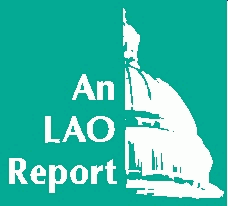
 | LAO
|
Require a statewide transportation needs assessment every five years.
The first step in identifying a solution to a problem is identifying the scope of the problem. Yet, when it comes to transportation, there is currently no requirement that Caltrans or any other state entity assess and report on the state's overall transportation needs on a regular basis.
While Caltrans and regional transportation planning agencies (RTPAs) must regularly update funding and scheduling documents, such as the State Transportation Improvement Program and the State Highway Operation and Protection Program, these documents provide no information about unfunded needs. Similarly, RTPAs are required to adopt 20-year long-range planning documents under both state and federal law, but these documents are not compiled to provide a view of the state's needs as a whole.
Please see California Travels: Financing Our Transportation,
May 2000, page 54.
Rebecca Long: 445-5921
Create high occupancy toll (HOT) lanes as a pilot program.
Single occupant vehicles make less efficient use of state highway capacity than carpools or buses. Charging drivers for the cost of driving, through the use of tolls, can encourage people to use alternatives to driving alone. In this way, tolls can serve as a type of user fee which can result in a more efficient use of the existing capacity on the state highway system.
In order to determine whether a more widespread use of road pricing is advisable, the Legislature should establish a pilot program to authorize HOT lanes. The HOT lanes allow single-occupant vehicles to buy access into the carpool lane for a fee, and thereby make greater use of any excess capacity in the carpool lane.
Please see HOV Lanes in California: Are They Achieving Their Goals?, January 7, 2000, page 20, and After the Transportation Blueprint: Developing an
Efficient Transportation System,
March 5, 1998, page 12.
Rebecca Long: 445-5921
Amend the State Constitution to permit the use of gas tax revenues for transit rolling stock.
The State Constitution (Article XIX) restricts the use of fuel tax revenues (gas and diesel taxes) to (1) construction, maintenance, and operation of roads and highways or (2) construction and maintenance of mass transit guideways and facilities (mainly rail tracks). Transit rolling stock (mainly railcars and buses) is the only type of transportation capital outlay that currently cannot use fuel tax revenues under Article XIX.
Modifying Article XIX to allow fuel tax revenues to be used for transit rolling stock would allow greater flexibility in the use of fuel tax revenues for the most cost-effective transportation projects.
Please see After the Transportation Blueprint: Developing and Funding an Efficient Transportation System, March 5, 1998, page 3.
Dana Curry: 445-5921
Broaden the eligibility criteria for advancing State Transportation Improvement Program (STIP) funding to counties.
Under current law, the regional share of the STIP is divided into county shares based on population and state highway miles. For a variety of reasons, most counties do not program the full amount of their share of project funds. The California Transportation Commission is authorized to advance the shares of county funds that are on reserve and loan them to other counties that have exhausted their share and identified projects in need of funding. However, current law limits the use of advances. As a result, the restrictions unnecessarily limit the use of state transportation funds, causing them to sit idle, rather than be put to work immediately.
Please see our 2000-01 Analysis, page A-51.
Rebecca Long: 445-5921